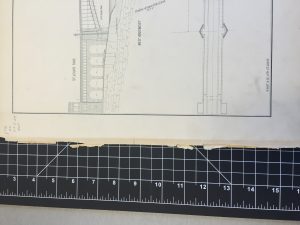Fold-out plates are often used to feature important illustrations or diagrams in many books related to science, technology, and history. Though a fold-out is designed to be frequently folded and unfolded, the stress on the creased fold lines from constant handling often causes the paper to break.
A book from the Smithsonian Libraries’s Research Annex collection entitled Illinois and St. Louis Bridge, by James B. Eads, contains many plates and a large fold-out. The fold-out had become detached from the textblock and was starting to tear along the creases.
In order to repair the damaged fold lines; proactively reinforce the other weak creases; and reattach the fold-out, Japanese paper adhered via wheat starch paste was determined to be an efficient and minimal intervention.
First, the diagram was spread out face down on a mat of blotter paper covered with a thin polyester sheet and small weights were placed near the torn fold lines to help flatten the paper and keep it in place:
Strips of very thin Japanese paper with long fibers were prepared and then brushed lightly with wheat starch paste:
The strips were carefully positioned over the torn creases on the fold-out and the fibers were gently brushed down and outward to blend with and adhere to the paper:
Once all of the tears were repaired and the weak creases reinforced, the strips were pressed with heavy weights and left to dry:
Later, the weights were removed and the repair work examined for deficiencies. All of the strips had adhered neatly and were minimally visible.
Next, the plate was carefully refolded along the newly repaired creases and then tested for strength and flexibility:
As the side of the fold-out that had once been attached to the textblock had become weak and ragged, this compromised area was carefully removed to create a clean edge and a heavier weight strip of Japanese paper was prepared and pasted to the back of the fold-out to serve as a new hinge:
At last the fold-out was positioned at the front of the textblock and pasted in:
Now repaired, reinforced and secured within the book, the fold-out is available again for interested researchers to view.





















One Comment
Was is scanned and or photographed so it did not have to be unfolded. And are such books placed online for all to read and study.